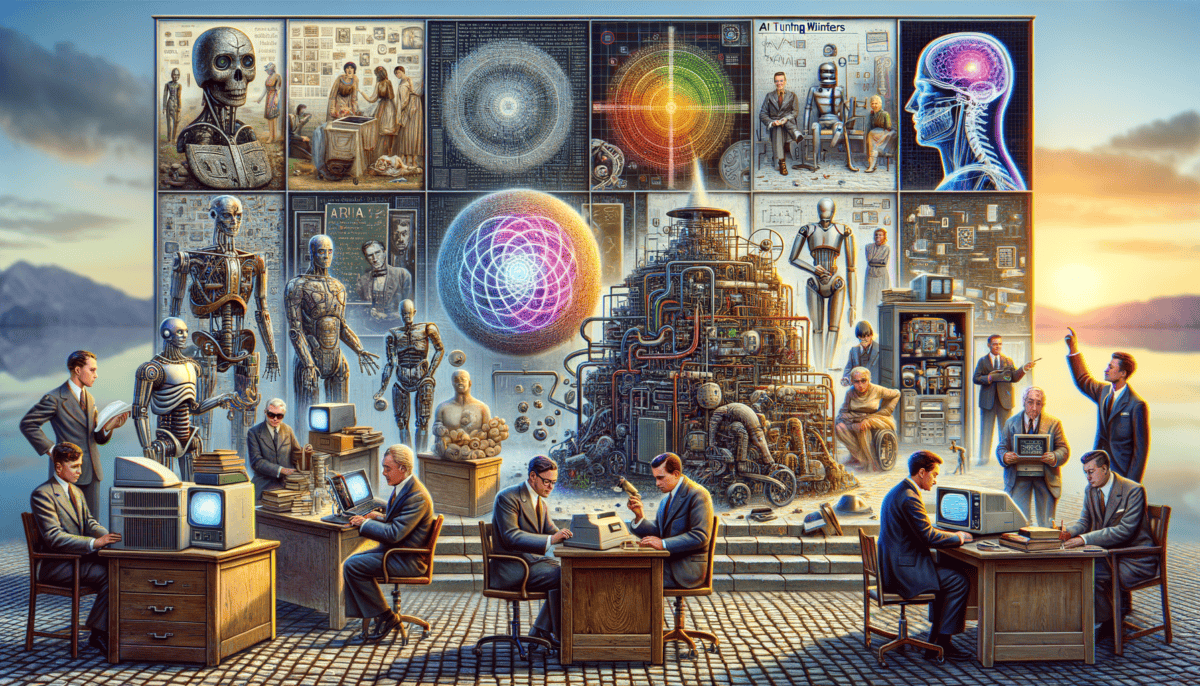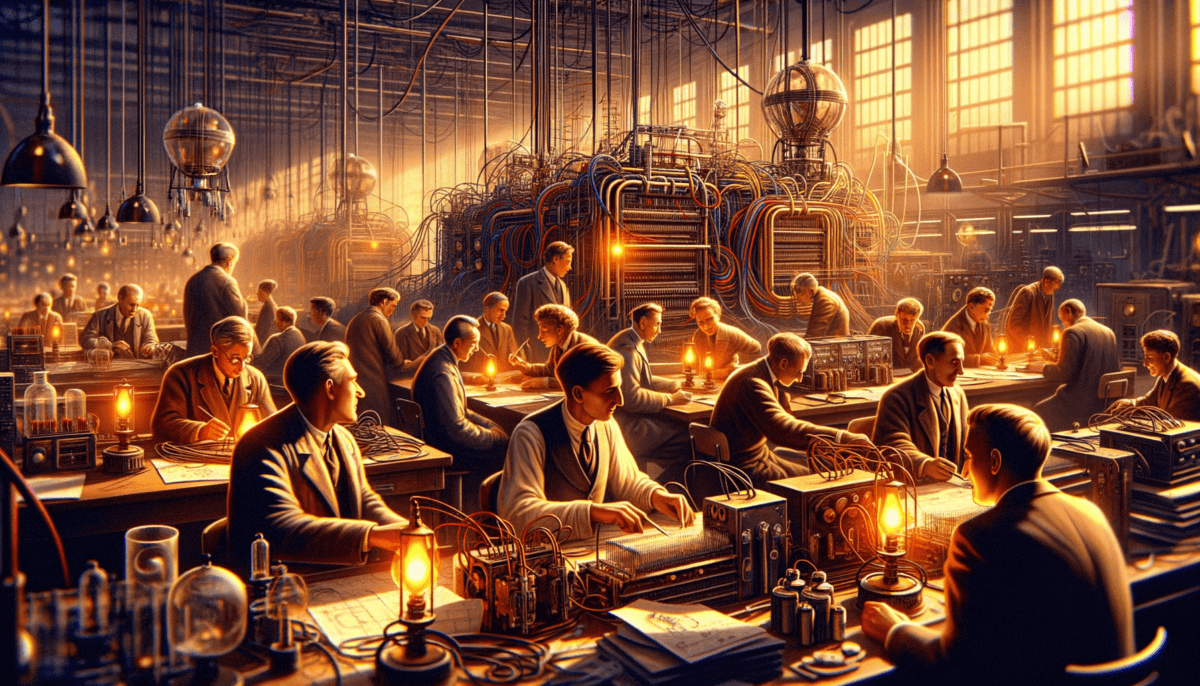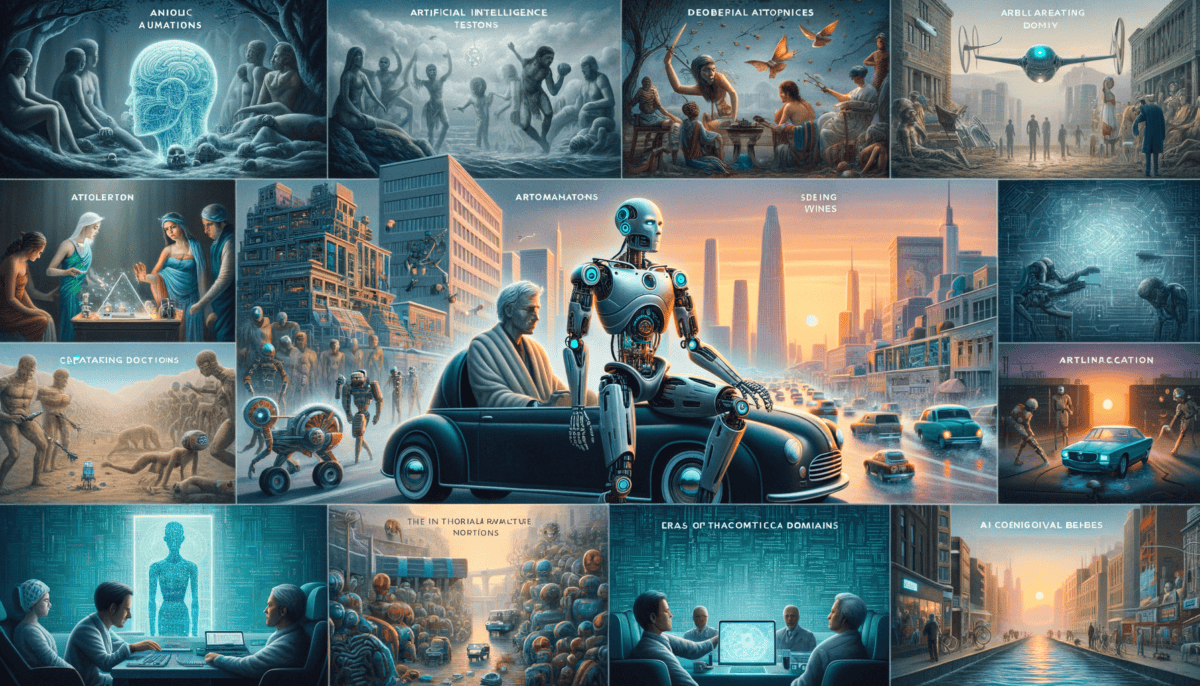Dreams of Mechanical Minds
Long ago, people loved to dream about making machines that could think like humans. In ancient Greece, there were stories about robots made of bronze that could walk and talk!
"Imagine a machine that could be your friend," young Sofia said to her grandfather as they sat in his cozy workshop. She was surrounded by old books and strange mechanical toys that her grandfather collected.
Her grandfather smiled and picked up an old book with golden pages. "Did you know that thousands of years ago, people already had big dreams about making thinking machines?"
Sofia's eyes grew wide. "Really? Tell me more!"
Ancient Dreams Come Alive
"In ancient Egypt, they built statues that seemed to move by themselves," Grandfather explained. "They used clever tricks with water and air to make them work. People thought they were magical!"
Sofia picked up one of her grandfather's mechanical toys – a little bird that could flap its wings when you wound it up. "But why did people want to make thinking machines?"
"That's a great question!" Grandfather leaned forward in his chair. "People have always wanted to create things that could help them. They dreamed of machines that could:
• Solve hard problems
• Remember important things
• Help with difficult work
• Keep them company
• Make their lives easier"
The First Steps
"In the 1200s, there was a clever man named Al-Jazari," Grandfather continued. "He made amazing machines that could pour drinks and play music! They weren't really thinking, but they showed what might be possible."
Sofia started bouncing with excitement. "Like my toy robot that can dance when I press buttons?"
"Exactly!" Grandfather laughed. "But back then, it was much harder to make machines do anything. They used water, weights, and gears instead of electricity."
Stories That Sparked Ideas
People wrote exciting stories about thinking machines. In China, there were tales about mechanical men who could do everything humans could do. In Europe, storytellers imagined wooden robots that could walk and talk.
"But were they scared of these machines?" Sofia asked, hugging her toy bird.
"Some were," Grandfather nodded. "But most people were just curious and excited. They saw these ideas as ways to make life better for everyone."
The Magic of Imagination
Sofia looked at all the mechanical toys in her grandfather's workshop with new eyes. Each one told a story about human dreams and creativity.
"The best part," Grandfather said, picking up a small clockwork dancer, "is that these ancient dreams didn't stay dreams forever. People kept trying to make them real."
He wound up the dancer, and it began to twirl gracefully. "Every invention starts with someone imagining what could be possible. Those old stories about thinking machines were like seeds that grew into something amazing."
"Like what?" Sofia asked, watching the dancer spin.
Grandfather's eyes twinkled. "Well, that's where the next part of our story begins. It's about the brave people who started turning these ancient dreams into reality…"
The Pioneers of Possibility
Sofia sat at her grandfather’s workbench, fiddling with a strange-looking machine. “What’s this one, Grandpa?” she asked, pointing to an old photograph of a man standing next to what looked like a giant calculator.
The Brilliant Mind of Alan Turing
“That’s Alan Turing,” Grandfather said warmly. “He was one of the most important people in making thinking machines real. He asked a very special question: ‘Can machines think?'”
“But how do you know if a machine is thinking?” Sofia wondered, scratching her head.
“That’s exactly what Turing wanted to figure out!” Grandfather smiled. “He made up a special game called the Turing Test. Want to play it?”
The Famous Turing Test
Grandfather grabbed two pieces of paper and some pencils. “Okay, let’s pretend you’re talking to someone through notes. You can’t see them or hear them. You just write questions, and they write back answers.”
“Like texting?” Sofia giggled.
“Just like that! Now, what if I told you one person was a human and one was a machine? Could you tell which was which just by their answers?”
Sofia’s eyes grew wide. “That would be hard! If the machine gives good answers, it must be thinking, right?”
The First Dream-Builders
Grandfather pulled out more old photos. “After Turing, more people started believing machines could really think. They were called computer scientists, and here are some things they dreamed of making:
- Machines that could play chess
- Computers that could solve math problems
- Programs that could understand human words ️
- Robots that could make decisions
Building the First Steps
“Did you know,” Grandfather said, pulling out an old blueprint, “that these scientists had to start really small? They made machines that could add numbers first. Then multiply. Then solve puzzles.”
“Like learning to crawl before you can walk?” Sofia asked.
“Exactly! Each tiny step was important. Every success made them believe more in their dreams.”
The Power of Believing
Sofia picked up another photo showing a room full of people working on early computers. “They look so happy!” she said.
“They were! These pioneers believed in something most people thought was impossible. They worked hard even when others said they were silly.”
A New Chapter Begins
Grandfather pulled out a box filled with old computer parts. “These pioneers showed us that thinking machines weren’t just stories anymore. They could be real!”
“What happened next?” Sofia asked eagerly, helping her grandfather sort through the parts.
“Well,” he said, picking up what looked like an old circuit board, “that’s when people started building something even more amazing – the first real computers. But that’s a story that needs its own special telling…”
Sofia leaned forward, ready to hear more about how dreams of thinking machines began to come true.
Building the Brain of Mathematics
“Remember those pioneers we talked about?” Grandfather asked, pulling a dusty metal box from his workshop shelf. “They had a big problem to solve – how to make a machine that could think using math.”
The Birth of ENIAC
Sofia’s eyes widened as Grandfather showed her a black-and-white photo. It showed a huge room filled with what looked like hundreds of metal cabinets.
“What’s that?” she asked, pointing at the strange sight.
“That’s ENIAC – the first big computer ever built! It was as big as a house and had thousands of parts.”
The Amazing Math Machine
“But why did they make it so big?” Sofia wondered.
Grandfather pulled out some old vacuum tubes from his box. “These were like the brain cells of ENIAC. Each one could do simple math, like adding or subtracting. To do big calculations, you needed lots of them!”
“Like how our brains have lots of tiny parts working together?” Sofia asked.
“Exactly! And guess who helped run this giant machine? Women! They were called the ENIAC programmers.”
The Programming Heroes
Grandfather showed Sofia another photo of six women standing in front of ENIAC.
“These ladies taught ENIAC how to think,” he explained. “They wrote special instructions called programs.”
“Like giving the machine a recipe to follow?” Sofia asked.
“That’s right! And sometimes they had to crawl inside ENIAC to fix things when they broke.”
Making Math Magic
Grandfather pulled out a simple calculator. “Today, this tiny thing can do math faster than ENIAC. But ENIAC showed us something important – machines could think with numbers!”
He wrote down some basic math symbols:
- + (add numbers together)
- – (take numbers away)
- × (multiply numbers)
- ÷ (split numbers up)
“These simple math signs helped machines start thinking. It was like teaching them their ABC’s!”
Solving Big Problems
“What did ENIAC work on?” Sofia asked.
“All kinds of important things! It helped:
• Figure out weather patterns ☔
• Design airplane wings ✈️
• Solve super hard math problems
Building Better Brains
“After ENIAC,” Grandfather continued, “people learned to make computers smaller and faster. They found new ways to make machines think.”
He showed Sofia a tiny computer chip. “This little thing can do more than ENIAC ever could. But we needed ENIAC to show us how to start.”
The Journey Continues
Sofia carefully held the old vacuum tube. “So these helped make the first thinking machine?”
“They sure did! But not everything worked perfectly. Sometimes the machines made mistakes. Sometimes they broke down. But the scientists never gave up.”
“What happened when things got hard?” Sofia asked, leaning closer.
Grandfather smiled mysteriously. “Well, that’s when things got really interesting…”
The Winter of Technological Dreams
Sofia noticed her grandfather’s smile fade a little as he put away the vacuum tube. “Sometimes, even great ideas hit big bumps in the road,” he said. ️
The First Frost
“What happened to all those amazing computers?” Sofia asked, wrapping her arms around herself as if feeling a chill.
“Well, people started to realize that making machines think was harder than they thought. Some folks got discouraged and stopped believing in AI.”
The Brave Few
Grandfather pulled out a photo album. “But not everyone gave up! Some scientists kept working, even when others said it was impossible.”
“Like who?” Sofia’s eyes sparkled with curiosity.
“Like Marvin Minsky,” Grandfather pointed to a picture. “He kept studying how to make machines learn, just like our brains do!”
Problems and Puzzles
“The machines had trouble with things that are easy for us,” Grandfather explained. “Like:
• Recognizing faces
• Understanding jokes
• Learning from mistakes
• Making choices like humans do
Never Give Up!
“Did the scientists feel sad?” Sofia asked.
“Sometimes. But they were like detectives solving a mystery. Each problem taught them something new!”
Hidden Treasures
Grandfather opened his laptop. “During the AI Winter, scientists made small but important discoveries. Like teaching computers to:
“Play chess ♟️
Solve math problems
Remember important information ”
The Light Through the Storm
“Even in the coldest winter, some flowers keep growing,” Grandfather said, showing Sofia a picture of a snowdrop pushing through snow. “The same thing happened with AI.”
“How?” Sofia leaned forward, excited.
“Well, some smart people figured out new ways to make machines learn. They started using something called ‘neural networks’ – like tiny computer brains!”
Hope Springs Again
“Did the winter ever end?” Sofia asked, helping Grandfather close the photo album.
“It sure did! And when it did, something amazing happened. The machines started doing things nobody thought possible!”
Lessons from the Cold
“The AI Winter taught us something very important,” Grandfather said, pulling Sofia onto his lap.
“What’s that?”
“That big dreams take time. And sometimes, when things seem the hardest, we’re just about to make our biggest breakthrough!” ✨
Sofia’s eyes lit up. “What kind of breakthrough?”
Grandfather grinned. “Well, that’s when the real magic began…”
The Digital Renaissance
Sofia bounced in her chair as Grandfather opened his tablet. “Remember how I said something magical happened after the AI Winter?” His eyes twinkled. “Well, get ready for the most exciting part!”
A New Dawn
“What happened, Grandpa?” Sofia leaned closer to the glowing screen.
“Scientists found a way to make computers learn like babies do – by looking at lots and lots of examples!”
The Magic of Machine Learning
Grandfather picked up Sofia’s stuffed bear. “How do you know this is a teddy bear?”
“That’s easy! It’s soft and furry and has a cute nose!” Sofia giggled.
“Well, scientists taught computers to recognize things the same way – by showing them thousands of pictures!”
Helping People Everywhere
“The new AI started doing amazing things to help people,” Grandfather explained. “Like:
• Helping doctors find sick cells
• Teaching cars to drive themselves
• Making video games more fun
• Translating languages instantly ️
Smart Phones, Smart Homes
“You know Siri on Mom’s phone?” Grandfather asked.
“The one that tells jokes?” Sofia grinned.
“Yes! That’s AI helping us every day. And look around our house – the smart lights, the robot vacuum, even the doorbell camera!”
Artists and Scientists
Grandfather opened an art app. “Watch this!” He typed something, and suddenly a beautiful picture appeared.
“Did the computer draw that?” Sofia’s eyes widened.
“Yes! AI can now make art, write stories, and even compose music!”
“AI is like having millions of helpers working together to solve problems and create beautiful things!”
Racing to the Future
“Companies started racing to build better AI,” Grandfather continued. “Like a friendly competition to see who could make the smartest helper.”
“Who won?” Sofia asked.
“Everyone did! Because each new discovery helped make the world better!”
Working Together
Grandfather showed Sofia a video of robots working in a hospital. “See how the robots and people work together? That’s the real magic – humans and machines helping each other!”
Growing Smarter
“Every day, AI learns new things,” Grandfather said. “Just like you do at school!”
“Does it have homework too?” Sofia laughed.
“In a way! It practices and practices until it gets better at helping people.”
The Big Questions
“But Grandpa,” Sofia looked serious, “with AI getting so smart, what happens next?”
Grandfather smiled warmly. “That’s a very good question. And it’s one that makes a lot of people think hard about the future…”
Humans and Machines – A Shared Future
Sofia snuggled closer to Grandfather as the evening light filtered through the windows. “So what happens next with AI?” she asked again.
Friends with Robots
“Well, sweetie,” Grandfather smiled, “right now we’re learning how to be good friends with our AI helpers.”
Making Good Choices
“Remember when you learned to share your toys?” Grandfather asked.
“Yes! It was hard at first, but then it was fun to play together!” Sofia nodded.
“That’s exactly how we need to think about AI – learning to share and work together!”
Keeping People First
Grandfather pulled out his old photo album. “Look at these pictures of your mom when she was little. What do you notice?”
“She’s playing outside! And reading books! And hugging you!” Sofia pointed.
“Right! Even with all our amazing AI friends, the most important things are still human things – like love, creativity, and kindness.” ❤️
Dreams for Tomorrow
Here are some wonderful things AI might help us do:
• Clean up the oceans
• Find cures for diseases
• Help everyone learn better
• Make safer cities ️
• Protect nature
Learning Together
“The best part,” Grandfather said, “is that AI can learn from us, and we can learn from AI!”
“Like how I teach my little brother things?” Sofia asked.
“Exactly! And just like you’re gentle with your brother, we need to be careful and responsible with AI.”
“The future isn’t just about smart machines – it’s about smart humans making wise choices.”
A World of Wonder
Sofia looked at her tablet, then back at Grandfather. “Will AI make everything perfect?”
“No, sweetie. Nothing is perfect. But AI can help make many things better if we use it wisely.”
Your Turn Now
Grandfather hugged Sofia tight. “You know what’s most exciting? You’ll help decide how we use AI to make the world better!”
“Me?” Sofia’s eyes sparkled.
“Yes, you! Every child today will shape tomorrow’s world with AI. Just remember to be kind, be wise, and always use your human superpowers – like love, imagination, and caring for others.” ✨
As the stars began twinkling outside, Sofia felt excited about the future. She knew that with AI as a helper and humans as the guides, tomorrow would be full of amazing possibilities. She couldn’t wait to be part of it all!
And as she drifted off to sleep that night, Sofia dreamed of a world where people and machines worked together to make everything a little bit better, a little bit kinder, and a lot more wonderful.






